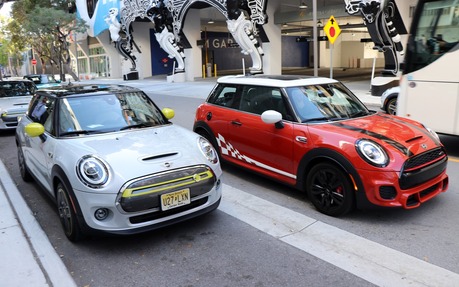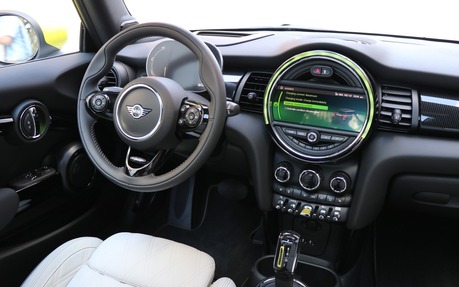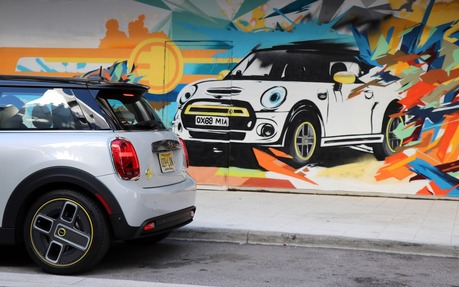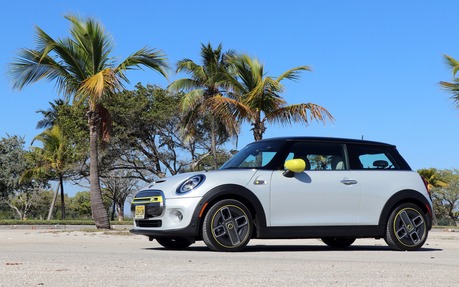2020 MINI Cooper SE: The Battery Game
We’re going to cut to the chase right away: the new, all-electric MINI Cooper SE offers disappointing range. With a small 32.6-kWh battery, it’s only marginally better than the first Ford Focus Electric and Nissan LEAF models.
The actual number is 177 kilometres—or about 110-120 kilometres in winter. Nothing to throw a scare into cars like the Chevrolet Bolt EV and Kia Soul EV.
- Also: Electric MINI Cooper SE Lands in Canada, Pricing Announced
- Also: All-electric MINI Cooper SE Unveiled with Around 250 Km of Range

All About the Drive
However, the MINI Cooper SE definitely has the edge when it comes to one little thing: fun. Sure, hitting the road silently in a LEAF is quite comfortable and pleasant, but the MINI combines all that with the power and sporty character of a Cooper S—minus the sound of the turbo engine, of course. Furthermore, at 1,365 kilograms, it only adds 145 kilograms to the weight of the Cooper S.
Lively acceleration, sharp steering and remarkable handling are all part of the experience, one that beautifully reconciles environmental protection with spirited driving. And with four driving modes plus two levels of energy recuperation, the Cooper SE perfectly adapts to your style and preferences on the road.
Incidentally, in its most aggressive setting, the car’s regenerative braking system makes it possible to only use the throttle around town (except for emergency situations). Knowing when to take your foot off the pedal in order to come to a stop at the right moment is a precision exercise we quite enjoyed throughout the week.

Classic MINI Interior
Inside the MINI Cooper SE, things are pretty much the same as in other MINIs: the centre console, the round centre display with an illuminated rim, the chrome toggle switches, etc.
The only difference, besides the yellow start/stop switch, is a cylinder-shaped, 5.5-inch digital instrument cluster behind the steering wheel that provides key information about the car’s electric powertrain though sleek graphics.
A real surprise comes from the fact that interior space is not affected at all. Since the battery is mounted under the floor, four adults can still take a seat with a reasonable amount of cargo room behind them.
Efficient Powertrain
Rated at 135 kilowatts (181 horsepower), the electric motor under the hood minimally alters weight distribution and balance so the Cooper SE still shows wonderful dynamics on the road.
Charging the battery takes approximately 3.5 hours using a 240V power source. With a DC fast-charging station, you can restore 80 percent of the battery in 35 minutes. Another good news is that heating the cabin has little effect on the car’s range. Why? Because engineers incorporated a special pump that captures heat generated by the motor, battery and wheels.
A mobile app allows owners to control cabin temperature remotely. It can also be used to monitor the charge level, get a history of energy consumption or locate nearby charging stations.

Pricing and Options
The 2020 MINI Cooper SE starts at $39,990. If you add $2,135 for freight and delivery (a ridiculously high amount) plus the applicable taxes, you get a price of $48,433. What about incentives? Well, there’s a $5,000 rebate from the Canadian government. Residents of Quebec and British Columbia can also save $8,000 and $3,000, respectively.
By comparison, the outgoing Volkswagen e-Golf is slightly cheaper and offers 24 extra kilometres of range.
In base Classic trim, the Cooper SE doesn’t have leather seats or a panoramic sunroof. It also must settle for 16-inch wheels, while other models are available with 17-inch wheels, including the Premier at $44,990 and Premier+ at $47,990.

Final Word
Back in 2008, select customers in California could lease a MINI Electric with a range of about 150 kilometres and just two seats (the rear bench was sacrificed for the battery).
The new 2020 MINI Cooper SE is much better, obviously, but it still has limited range and must be viewed as a luxury toy designed essentially for city driving—or perhaps a second car for families where one parent doesn’t have long commutes to work.
Ironically, the same motor can be found in the BMW i3, which can travel up to 246 kilometres on a full charge. MINI is leaving the door open to an extended-range variant in the short-to-medium term. However, that will require increasing the energy density of the battery, because there’s just not enough space right now to fit a larger pack.
